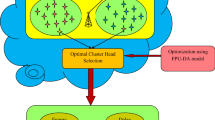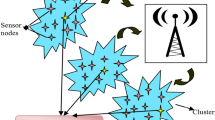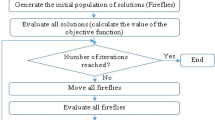Abstract
Clustering is considered to be the most significant method for resolving conflicts of data transmission and maximizing the life span of the network in Wireless Sensor Networks (WSNs). The sensor nodes are densely deployed to satisfy the coverage requirement; this causes some nodes to lazy mode. Some algorithms of cluster heads (CHs) selection were already proposed for sufficient energy management. However, it remains as a challenging task in WSN due to network scalability, protocol characteristics, and data transfer rate. This paper aims to propose a novel clustering model is proposed by this research work for cluster head selection (CHS) that considers four primary constraints: namely energy consumption, delay, distance, and security. In addition, for optimal selection of CH, a novel algorithm, which is the hybridization of the Dragon Fly (DA) algorithm and firefly algorithm, is proposed. The proposed hybrid algorithm is named as FireFly replaced Position Update in Dragonfly (FPU-DA). The performance of the proposed work is compared with conventional algorithms. Subsequently, a parametric analysis is performed by varying the weight factor of the proposed FPU-DA model to investigate its impact on the performance of the CHS problem. The proposed FPU-DA model at round 2000 shows 9%, better than KNN and SOM. Thus, the analysis results proved that the proposed model attains a better life span when compared to that of other conventional models.







Similar content being viewed by others
Abbreviations
- WSN:
-
Wireless sensor networks
- CH:
-
Cluster head
- CHS:
-
Cluster head selection
- DA:
-
Dragon fly
- FF:
-
Firefly algorithm
- BS:
-
Base station
- FPU-DA:
-
FF replaced position update in DA
- FMCR-CT:
-
Fuzzy multi cluster-based routing with constant threshold
- GA:
-
Genetic algorithm
- ENEFC:
-
Energy-efficient clustering
- HRMH:
-
Hierarchical routing using multi-hop
- HRML:
-
HR using multilevel
- NAN:
-
Number of alive nodes
- NNE:
-
Normalized network energy
References
Ahmad A, Javaid N, Qasim U, Ishfaq M, Khan ZA, Alghamdi TA (2014) RE-ATTEMPT: a new energy-efficient routing protocol for wireless body area sensor networks. Int J Distrib Sens Netw 10(4):464010
An J, Qi L, Gui X, Peng Z (2017) Joint design of hierarchical topology control and routing design for heterogeneous wireless sensor networks. Comput Stand Interfaces 51:63–70
Bansal S (2018) Nature-inspired-based multi-objective hybrid algorithms to find near-OGRs for optical WDM systems and their comparison. Biomimicry Inf Retri Knowl Manag. https://doi.org/10.4018/978-1-5225-3004-6
Bansal S (2019) A comparative study of nature-inspired metaheuristic algorithms in search of near-to-optimal Golomb rulers for the FWM crosstalk elimination in WDM systems. Appl Artif Intell 33(14):1199–1265
Bansal S (2020) Performance comparison of five metaheuristic nature-inspired algorithms to find near-OGRs for WDM systems. Artif Intell Rev. https://doi.org/10.1007/s10462-020-09829-2
Bansal S, Singh AK, Gupta N (2017) Optimal golomb ruler sequences generation for optical WDM systems: a novel parallel hybrid multi-objective bat algorithm. J Inst Eng India Ser B 98(1):43–64
Baskaran M, Sadagopan C (2015) Synchronous firefly algorithm for cluster head selection in WSN. Sci World J 2015:1–7. https://doi.org/10.1155/2015/780879
Bhatti DMS, Saeed N, Nam H (2016) Fuzzy C-means clustering and energy efficient cluster head selection for cooperative sensor network. Sensors 16(9):1–17
Enami N, Moghadam R (2010) Energy based clustering self organizing map protocol for extending wireless sensor networks lifetime and coverage. Can J Multimed Wirel Netw 1(4):42–53
Fakhet W, Khediri SE, Dallali A, Kachouri A (2017) New K-means algorithm for clustering in wireless sensor networks. In: International conference on internet of things, embedded systems and communications (IINTEC), Gafsa, Tunisia, pp 1–5
Hao P, Qiu W, Evans R (2010) An energy-efficient cluster-head selection protocol for energy-constrained wireless sensor networks. In: Zheng J, Mao S, Midkiff SF, Zhu H (eds) Ad Hoc networks. ADHOCNETS 2009. Lecture notes of the institute for computer sciences, social informatics and telecommunications engineering, vol 28. Springer, Berlin
Intanagonwiwat C, Govindan R, Estrin D (2000) Directed diffusion: a scalable and robust communication paradigm for sensor networks. In: Proceedings of the 6th annual international conference on mobile computing and networking, Boston, pp 56–67
Jafari M, Chaleshtari MHB (2017) Using dragonfly algorithm for optimization of orthotropic infiniteplates with a quasi-triangular cut-out. Eur J Mech A Solids 66:1–14
Kang SH, Nguyen T (2012) Distance based thresholds for cluster head selection in wireless sensor networks. IEEE Commun Lett 16(9):1396–1399
Lee K, Lee J, Lee H, Shin Y (2010) A density and distance based cluster head selection algorithm in sensor networks. In: 2010 the 12th international conference on advanced communication technology (ICACT), Phoenix Park, pp 162–165
Liaqat T, Akbar M, Javaid N, Qasim U, Khan Z, Javaid Q, Alghamdi T (2016) On reliable and efficient data gathering based routing in underwater wireless sensor networks. Sensors 16(9):1391
Mazinani A, Mazinani SM, Mirzaie M (2018) FMCR-CT: an energy-efficient fuzzy multi cluster-based routing with a constant threshold in wireless sensor network. Alex Eng J, corrected proof, Available online 26 December (in press)
Muthukumaran K, Chitra K, Selvakumar C (2018) An energy efficient clustering scheme using multilevel routing for wireless sensor network. Comput Electr Eng 69:642–652
Sabet M, Naji HR (2015) A decentralized energy efficient hierarchical cluster-based routing algorithm for wireless sensor networks. AEU Int J Electron Commun 69(5):790–799
Wang T, Zhang G, Yang X, Vajdi A (2018) Genetic algorithm for energy-efficient clustering and routing in wireless sensor networks. J Syst Softw 146:196–214
Zhao Z, Peng M, Ding Z, Wang W, Poor HV (2016) Cluster content caching: an energy-efficient approach to improve quality of service in cloud radio access networks. IEEE J Sel Areas Commun 34(5):1207–1221
Zhou Z, Dong M, Ota K, Wang G, Yang LT (2016) Energy-efficient resource allocation for D2D communications underlaying cloud-RAN-based LTE-a networks. IEEE Internet Things J 3(3):428–438
Zhou Z, Gong J, He Y, Zhang Y (2017) Software defined machine-to-machine communication for smart energy management. IEEE Commun Mag 55(10):52–60
Funding
The author would like to thank the Deanship of Scientific Research at Umm Al-Qura University for supporting this work by Grant Code: 19-COM-1-01-0002.
Author information
Authors and Affiliations
Contributions
The author has come out with the proposed idea; he had make sole contribution for the development and carried out all the research work.
Corresponding author
Ethics declarations
Conflict of interest
Not applicable.
Additional information
Communicated by V. Loia.
Publisher's Note
Springer Nature remains neutral with regard to jurisdictional claims in published maps and institutional affiliations.
Rights and permissions
About this article
Cite this article
Alghamdi, T.A. Parametric analysis on optimized energy-efficient protocol in wireless sensor network. Soft Comput 25, 4409–4421 (2021). https://doi.org/10.1007/s00500-020-05449-8
Published:
Issue Date:
DOI: https://doi.org/10.1007/s00500-020-05449-8




